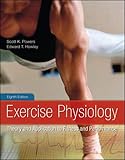Exercise physiology : theory and application to fitness and performance / Scott K. Powers.
Material type: TextPublication details: New York : McGraw-Hill Humanities/Social Sciences/Languages, c2012Edition: 8th edDescription: xv, 587, [36] p. : ill. (some col.) ; 29 cmISBN: 9780078022531 (hardback)Subject(s): Exercise -- Physiological aspects | MEDICAL / Sports MedicineDDC classification: 612/.044 LOC classification: QP301 | .P64 2012Other classification: MED084000
TextPublication details: New York : McGraw-Hill Humanities/Social Sciences/Languages, c2012Edition: 8th edDescription: xv, 587, [36] p. : ill. (some col.) ; 29 cmISBN: 9780078022531 (hardback)Subject(s): Exercise -- Physiological aspects | MEDICAL / Sports MedicineDDC classification: 612/.044 LOC classification: QP301 | .P64 2012Other classification: MED084000 | Item type | Current library | Home library | Collection | Call number | Copy number | Status | Date due | Barcode |
|---|---|---|---|---|---|---|---|---|
 Open Books
Open Books
|
MCHS LIBRARY--LL Malawi College Of Health General Stacks | MCHS LIBRARY--LL Malawi College Of Health General Stacks | Non-fiction | WA 781 POW 2011 (Browse shelf(Opens below)) | 1 | Available | L06949 |
Browsing MCHS LIBRARY--LL Malawi College Of Health shelves, Shelving location: General Stacks, Collection: Non-fiction Close shelf browser (Hides shelf browser)

|
No cover image available No cover image available | No cover image available No cover image available |

|

|

|

|
||
| WA 781 HOE 2012 Principles and labs for fitness and wellness / | WA 781 HOE 2012 FITNESS AND WELLNESS | WA 781 POW 2011 Total fitness and wellness/ | WA 781 POW 2011 Exercise physiology : | WA 84.1 BAR 2016 Leadership in health care / | WA 850 ARG 2011 Statistics for research : with a guide to SPSS / | WA 850 HAR 2021 MEDICAL STATISTICS MADE EASY |
Includes bibliographical references and index.
Machine generated contents note: SECTION 1: Physiology of ExerciseChapter 0: Introduction to Exercise Physiology Chapter 1: Measurement of Work, Power, and Energy ExpenditureChapter 2: Control of the Internal EnvironmentChapter 3: Bioenergetics Chapter 5: Cell Signaling and the Hormonal Responses to ExerciseChapter 6: Exercise and the Immune System Chapter 7: The Nervous System: Structure and Control of MovementChapter 8: Skeletal Muscle: Structure and Function Chapter 9: Circulatory Responses to ExerciseChapter 10: Respiration During ExerciseChapter 11: Acid-Base Balance During ExerciseChapter 12: Temperature RegulationChapter 13: The Physiology of Training: Effect on VO2 Max, Performance, Homeostasis, and Strength -- SECTION 2: Physiology of Health and FitnessChapter 14: Risk Factors and Inflammation: Links to Chronic DiseaseChapter 15: Work Tests to Evaluate Cardiorespiratory FitnessChapter 15: Work Tests to Evaluate Cardiorespiratory FitnessChapter 16: Exercise Prescriptions for Health and FitnessChapter 17: Exercise for Special PopulationsChapter 18: Body Composition and Nutrition for Health -- SECTION 3: Physiology of PerformanceChapter 19: Factors Affecting PerformanceChapter 20: Laboratory Assessment of Human PerformanceChapter 21: Training for PerformanceChapter 22: Training for the Female Athlete, Children, Special Populations, and the Masters AthleteChapter 23: Nutrition, Body Composition, and PerformanceChapter 24: Exercise and the EnvironmentChapter 25: Ergogenic AidsAppendixes.
"Written especially for exercise science and physical education students, this text provides a solid foundation in theory illuminated by application and performance models to increase understanding and to help students apply what they've learned in the classroom and beyond. "-- Provided by publisher.


There are no comments on this title.